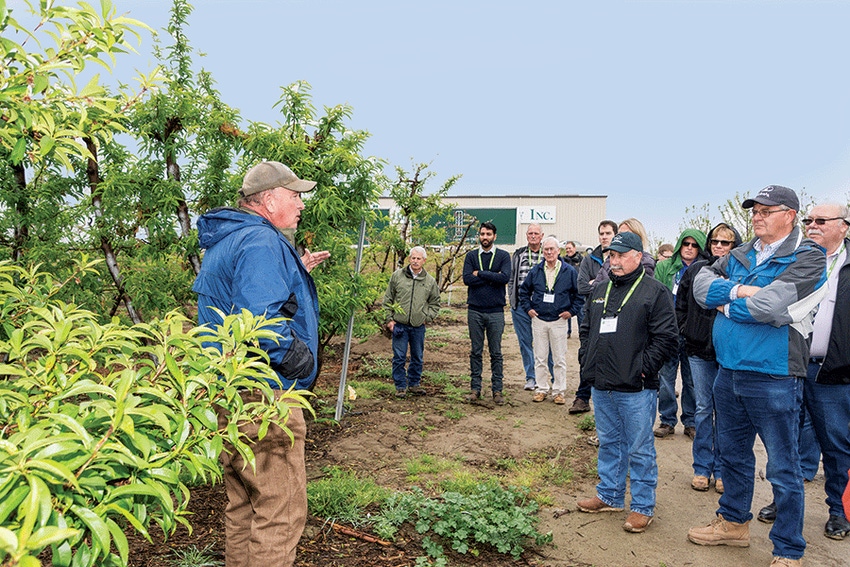
Planting almonds is more than buying trees and sticking them in the ground. Growers have much to consider, including variety choices and rootstocks, but these are perhaps more critical for the nurseries, which must bear the brunt of research and development into what works, what doesn’t, and the various growing conditions to which farmers may subject the trees.
California-based Burchell Nursery has found success through its plant breeding programs. Over the years it has introduced many of the mainstay varieties common throughout the industry: Carmel, Monterey, Fritz, Livingston and Wood Colony — all are Burchell varieties. Each year the nursery sells more than three million fruit and nut trees, and boasts over 150,000 square feet of greenhouse space and 1,000 acres of growing fields.
Burchell’s introduction of the Shasta variety could open a new world of self-fertile almond trees that require significantly fewer bees for pollination. Though nobody is suggesting just yet that bees will become obsolete in almond orchards, self-fertile varieties technically do not need bees to pollinate them, according to John Slaughter, Burchell plant breeder. His work suggests that a minimal number of bees (perhaps one colony per two acres) is optimal for these varieties.
He says Shasta can produce larger nuts than the industry mainstay Nonpareil variety, and according to Burchell Field Representative Ron Boone, the variety has gained popularity with buyers in India who are looking for a large nut with certain flavor characteristics.
While the larger Shasta has good utility, it’s typically not the snack nut used in domestic products, says Slaughter. The goal with Shasta is increased spur and lateral growth, “not just lumber, but fruiting shoots and spur retention.”
“I think it was 19 years ago when I made that cross,” Slaughter says. He crossed Tuono, a European variety, with a numbered selection at the nursery to come up with a tree that today takes its name from a large, northern California volcano.
He also wanted the hardness and sealed characteristics of Tuono, while creating a nut that had a larger kernel in proportion to its shell. Increasingly important is shell impermeability, since insect damage in the past few years has significantly boosted kernel reject levels at processors.
“We wanted no insect access, and self-fertility, which Tuono has,” he says.
NEW VARIETY PLANNING
New varieties don’t appear overnight. Plant breeding and genetics involve a slow, painstaking process, with an intense amount of labor, time, trial and error, and constant study before a new variety is released. Some may never make it to the public for a variety of reasons.
Buyers and consumers must be factored into new variety planning, Slaughter says. That’s why part of the process includes bringing test blocks of trees to production, then moving the nuts through the supply chain — first to processing, then to buyers, then to consumers to test their acceptance in the marketplace.
Another effort under way is to find a replacement for the Carmel variety, which is not dependable or productive, he says, and bud failure can be common.
Slaughter talks about trees in ways many may not be aware of, but he can explain well. He likes a full canopy, large kernels, and efficiency, which can be seen in the density of nuts on the tree. Part of what he looks at are how the trees grow — do they grow straight up, or do they grow more laterally, and do they produce more fruit?
He also notes University of California light interception studies by Cooperative Extension Specialist Bruce Lampinen, which have demonstrated how specific amounts of light in an almond orchard can have positive effects on yield.
MORE PRODUCTION, EFFICIENCY
Growers increasingly want greater efficiency and faster production, Slaughter says. “There is an ever-increasing pressure for quicker yields and black ink.”
For example, the Nonpareil, a large tree with a full canopy and nut characteristics the marketplace likes, is not as efficient as it could be, he says, while the Butte variety is a smaller nut on a larger tree with “an incredible spur dynamic.” Independence trees produce a good nut and are highly-productive trees early on, but they do it on a smaller tree. Burchell’s Wood Colony variety produces large kernels, has great efficiency, but is a small tree. Smaller trees lend themselves to tighter planting configurations.
Within canopy structure — whether branches grow up or out — is the potential to set more fruit, plus other characteristics that can lead to crop success.
Among questions Slaughter considers: “If we’re going to get 40 tons per acre over the lifetime of an orchard, can we do that in 12 years versus 17 years to 20 years, and then start over with a higher-density, quicker-yielding block?”
Dwarfing varieties are starting to gain traction with some growers, but he says, “the jury is still out. If you’re limited to an 8-foot canopy that is 3 feet to 4 feet wide, then you’d better have solid nuts on those trees to do what guys with full-size trees are doing.”
Slaughter is also watching Dr. Grant Thorp, an orchard systems specialist in Australia who is working on ways to double almond production while decreasing inputs. “Dr. Thorp has done that in avocados,” he says.
He’s also monitoring technological advances in shake-and-catch almonds, rather than dropping them onto the ground. These methods hold promise for food safety, harvest efficiency, and dust control. Another method Slaughter is watching is field hulling of almonds during the harvest process, which he says then allows recycling of hulls into the field to provide a useful source of potassium, an important and expensive fertilizer.
“Why would you haul away the potassium you just paid for?” he asks.
##
About the Author(s)
You May Also Like






